Physics
Full History
40 years of Physics at the University of Regina:
Building a Research Tradition in Challenging Times
by G.M. Huber, G.J. Lolos, E.L. Mathie
(published in Physics in Canada - Jul/Aug 2000)
I - THE DEVELOPMENT OF THE UNIVERSITY OF REGINA
Although the University of Regina is one of Canada's younger universities, its modest roots date to 1911, when the Methodist Church established Regina College (R.C.) as a residential high school, near the heart of the young settlement. Fine arts were a key component of the curricula, and it remains home to one of only a few music and dance conservatories in Canada, today. In 1925, R.C. became a junior college of the University of Saskatchewan, and began to offer first-year arts and sciences classes. Not long afterwards, in the 1930s, the ownership of the college was transferred to the University of Saskatchewan; second year university classes were added to the college offerings, and the high school program was discontinued. During the 1950s, a School of Art was created, and the Norman Mackenzie Art Gallery, featuring a major collection focusing on Canadian historical and contemporary art, was established. Later, with the onset of the ''baby boom'', pressure for a fully-fledged second campus of the University of Saskatchewan to serve Regina and the southernmost portion of the province intensified, finally culminating in Regina College acquiring degree-granting status as the University of Saskatchewan - Regina Campus (US-RC), in 1961.
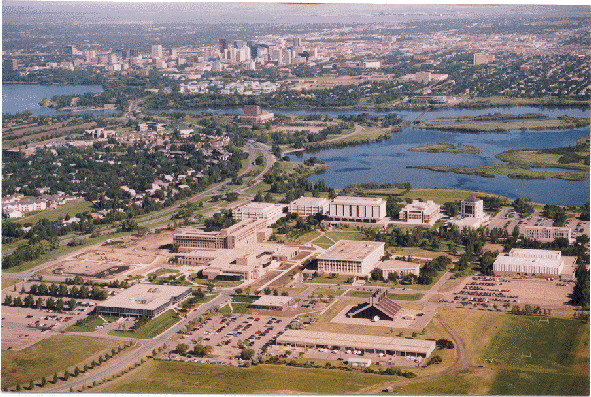
Fig.1: Photo of the University of Regina campus, taken in 1997, looking north. The university fronts on the Wascana Lake waterfowl preserve. Downtown Regina is in the distance.
Regina Campus, as it became known, embarked on a program to expand its physical facilities, and a new 330 acre campus site was selected on the grounds of the Canada Agriculture Experimental Farm, 3 km southeast of the old college. With the selection of the campus location, it immediately became apparent that Wascana Lake was entirely surrounded by the provincial legislature, city parks, museums, and the new university. It was decided to designate this area as one of the world's largest urban parks, and the 2000 acre Wascana Centre was established. An international competition for the design of both the campus and park was launched, and Minoru Yamasaki was selected as master architect. He later become internationally renowned for the twin tower World Trade Centre in New York. Regarding his new assignment, Mr. Yamasaki stated "The opportunity to build a completely new and integrated university on bare land is one which occurs very infrequently in our times... A University is symbolic of the highest aspiration of man, and the physical environment which is built for its activities must strive to attain the nobility of these aspirations. It must have great dignity and yet not be pompous -- it must be warm and friendly and yet must give the kind of atmosphere which is conducive to study and to research. Beyond all this, it must be a useful plant to serve the needs and functions of the University.'' His design was highly practical for the cold prairie winter, with the buildings located close enough together that passage between them could be provided through connecting corridors in a common "podium'' level, larger than the remaining floors of the buildings rising above it, thereby creating the impression of separate buildings rising from a common base.
Construction began immediately on the new campus, and the first buildings opened for use in 1965. During the 1960's, the campus developed rapidly, with a 21% increase in student enrollment each year. Programs in science, art, fine arts, administration, education, graduate studies, engineering and social work were either expanded or created. The US-RC held its first convocation in 1965, granting its first honorary degree to then-Prime Minister, Lester B. Pearson. The institution continued to grow and in 1974, the University of Regina (UofR) was established by statute as an independent institution. The enrollment of the university continued to climb, but at a more modest pace, and programs in Journalism and Engineering were expanded.
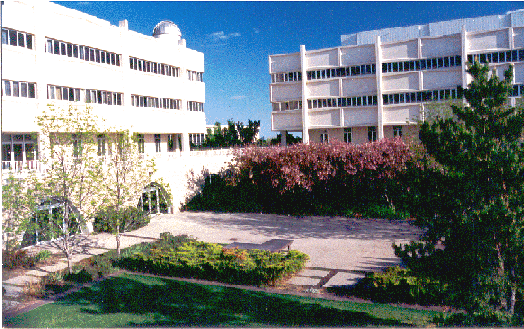
Fig. 2: A view of the buildings housing the physics department. These are the first two buildings constructed on the new campus. The building on the right is home to the departments of physics, chemistry and biology, with physics labs and offices occupying portions of the first and second floors. The building on the left houses instructional astronomy labs on the top floor.
Presently, the University of Regina has about 12,000 students, including nearly 1,000 graduate students, placing it in the ''comprehensive'' category of Canadian universities. The 1990's have been largely a time of consolidation, with stable student enrollment, and the retirement of a large fraction of the original faculty members hired in the 1960's. In recent years, the University of Regina has lead the country with the most rapid increase of federal government (NSERC) research grants of any university in Canada. From 1993-4 to 1998-9, the increase in these grants was approximately 120% (i.e. more than double). The most recent addition to the campus is an adjoining research park, whose key emphases are the fields of Information Technology and Energy Research.
II - THE FORMATION OF THE PHYSICS DEPARTMENT
Because there was no science tradition at Regina College, the development of an active physics department at the new university encountered a number of challenges. Regina at large was ill prepared for the logistics that a major new university required, but it was welcomed by some segments of the population, and the intellectual atmosphere at the university was exciting. Recent sales of Saskatchewan grain to the Soviet Union had created a lot of optimism, and the future of the university looked promising. Academically, interdisciplinary interaction was expected to be a characteristic of the new institution, and new curriculum experiments were being attempted in almost every sector. There were no departments as such, but only discipline specific committees, and Science was a division (headed by an associate dean) within the Faculty of Arts and Sciences. This was changed very soon when it became clear that disciplines had needs of their own and that "interdisciplinarism" could not be promoted from the top, but had to reflect true personal interests of the researchers. The situation improved for Physics when the head of the department, Joe Wolfson, became the new head of the Science division. He had worked at Chalk River, knew what physics was about and was a person of great integrity and farsightedness. As he was originally from the prairies, he also knew how to develop ties with the local community.
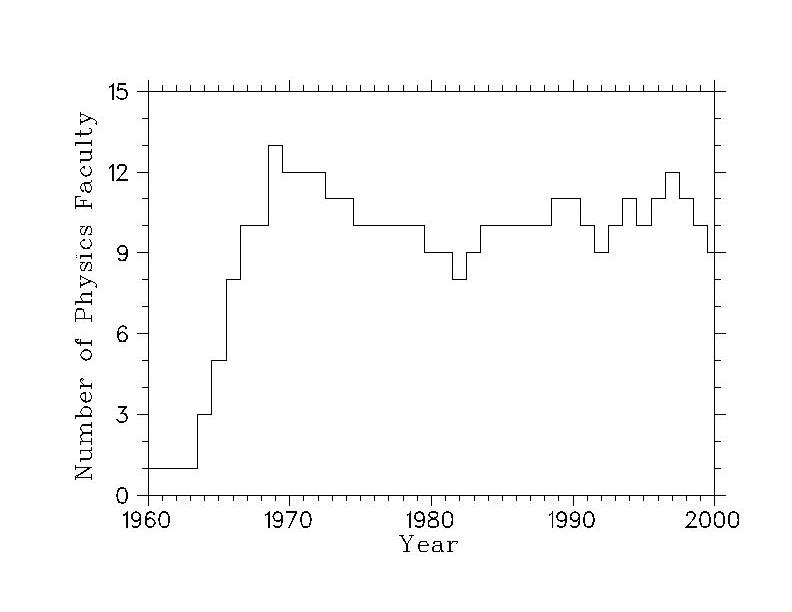
Fig.3: Graph of number of full time physics faculty versus year at the UofR.
The province's less buoyant economic times to follow would aggravate the situation considerably. It soon became clear that, in order to survive, the department had somehow to develop research and teaching areas that would not overlap with what was already established Saskatoon, and needed to attract both undergraduate and graduate students. Since, by 1970 the department had developed some expertise in low temperature physics, it was decided to try a concerted approach to the detection of gravity waves, whose detection would be a striking confirmation of the general theory of relativity, and whose probable observation had been reported by J. Weber of the University of Maryland. This was the first attempt of the department to undertake an independent, major research program. The details are described in a later section, but it will suffice to state for now that it had the positive legacy of establishing the department's research reputation within the province.
During the 1970s, the physics department shrank in size by nearly 40%, and in fact has never regained the faculty level it had in 1969. After the termination of the gravity wave project, the department went through a period of slow decline, which was not arrested until the establishment of the intermediate energy experimental group in 1983-4. One of the lessons learned from the gravity wave project was the concept of a critical mass of researchers in one area, which is especially important in Regina, because of its distance from the research-intensive physics departments of the east. Since this time, the department's commitment to subatomic physics research has both deepened and broadened, with 75% of the present faculty members doing research in either experimental or theoretical nuclear and particle physics. As will be described later, close ties are maintained with collaborators at TRIUMF and Jefferson Lab, and sometimes further afield at Brookhaven, NIKHEF (Amsterdam), and Tokyo. Close links with international collaborations play a key role in the academic life of the department, and graduate students receive close supervision in a mutually supportive environment.
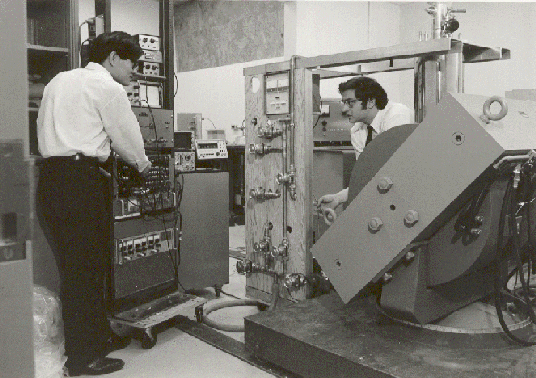
Fig. 4: 1971 photo of the NMR spectrophotometer, with graduate student Thian Ng (left), and Dr. E. Tward (right).
In addition to its regular and honours B.Sc., M.Sc. and Ph.D. offerings, the physics department has recently embarked on a new initiative in undergraduate education. In collaboration with the Faculty of Engineering, and the Department of Computer Science, B.Sc. programs in Applied/Industrial Physics were recently started. These degree offerings are unique in Canada. The program in Electronics and Modern Physics provides classes up to the fourth year of undergraduate physics, and also incorporates selected classes20in Electrical Engineering. The program in Computation and Physical Modelling provides selected classes in Computer Science and Engineering, in addition to the physics component. A compulsory co-op education component, in which the students complete work terms with participating industrial employers, provides additional applied training. We expect that this innovative program will be accepted by potential Co-op employers, as we have received many student inquiries
III - THE ROLE OF RESEARCH IN THE DEPARTMENT
The physics department takes pride in being widely acknowledged as one of the most research intensive departments of the University of Regina. It is the smallest physics department in Canada to offer the Ph.D. degree. The following is a summary of some of the research performed by the department since its inception. Unfortunately, it is impossible to describe every contribution, so only the highlights are touched upon. A listing of each of the faculty members that have been in the department, and their individual research contributions, is given in table 1.
1 - GRAVITY WAVE ANTENNA PROJECT
The question of the existence of gravitational waves was first raised by Einstein in 1916, however the first experimental tests were not undertaken until the 1960's. The excitement generated by these experiments led to an intense effort around the world throughout the 1970's, including at Regina, where the "gravity wave project" represented the biggest effort of the department for many years, with contributions from most of the department members at one time or another.
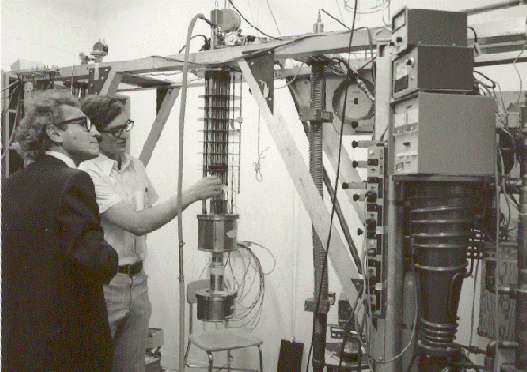
Fig. 5: Postdoctoral fellow, Don Strayer (rear) explains the operation of the gravity wave apparatus to Dr. Weber (foreground), during a 1975 visit to Regina.
Gravity waves propagate (at the speed of light) by an action of stretching and compressing, which effects all matter. Since the coupling of gravity to matter is weak, the displacement induced by the wave is extremely small and observations of it are clouded by noise due to seismic, electromagnetic, vibrational, cosmic and thermal sources. The thermal noise was thought to be the limiting factor, and the efforts in Regina focussed upon cooling the antenna, as well as tuning the antenna to the expected frequency of the incoming wave. The inherent difficulty of detection of the wave is complicated by the variety of expected sources, such as binary star systems, which are distant and emit waves at low frequency, through to rare sources such as collapsing stars or binary neutron stars, which emit waves in short bursts.
The approach taken in Regina followed upon the pioneering experimental work of J. Weber (Maryland), in which the resonance of an antenna is detected whenever a passing gravitational wave contains sufficiently large components with the eigenfrequencies of the detector. Relatively small antennae (both aluminum and quartz crystal) with very high Q values were fabricated for operation at low temperatures. At a temperature of 4K, one of the local groups reported Q values for an aluminum detector in excess of one million. A novel quartz crystal detector, which served as both antenna and transducer, was eventually cooled to 15 mK (a tremendous achievement, although somewhat short of the 3mK goal). The infrastructure developed for this work included helium liquification and recovery systems, test cryostats and the SQUID system. Because of the proximity of the university to the Trans Canada Highway and the ever-present prairie wind, the apparatus required vertical and horizontal vibrational dampers, so the apparatus was housed in an underground, off campus laboratory, located 16 km from Regina. Operation and development of the facility were hampered by both the Saskatchewan winter and the lack of local manufacturers for specialized equipment.
The enterprising spirit of the project staff is shown in their solution to shortages in the helium gas supply. When additional helium gas was required, two researchers would drive 250 km west to a natural gas field near Swift Current, and collect the required gas in a special trailer, fitted with high pressure gas bottles. In additional to this natural supply, leftover gas from atmospheric balloon studies in Saskatoon was also sometimes used.
Research funding for the project was held by Dr. Papini throughout the 1970's. Other faculty members working on the gravity wave antenna project included Drs. Barton, Kos, Tward and Wolfson, and for a brief period, Dr. Pachner. In addition to the faculty members, the project was supported by a number of research associates and technical staff, including B. Ramadan, Dr. D. Strayer and K. Wolbaum. In 1977, a breakthrough in SQUID research made all groups working on low temperature gravity wave antennae realize that the limiting factor was not the Brownian noise in the detector itself, but the noise in the SQUID amplifier, which could drive the antenna and generate signals beyond the thermal noise. The problem proved intractable and delayed the work considerably, while unsuccessful attempts were made to fund the in loco construction of a low noise dc SQUID. The project was abandoned in 1979, and the group dispersed. The project played an important role in establishing the University of Regina as an independent research organization. In recent years, the intended measurement sensitivities of the Regina project have finally been reached (in Rome), however, the ongoing effort to directly observe gravitational waves has still not yielded positive results and remains a problem of fundamental conceptual importance.
2 - X-RAY CRYSTALLOGRAPHY STUDIES
X-ray crystallography was a major area of research in the department from its inception. The first crystallographer in the department was Dr. Stanley, who received NRC grants for a Picker X-ray diffractometer in 1966 and 1970. Dr. Stanley was appointed to a position within the president's office in 1969, and Dr. Robertson was recruited to supplement the group.
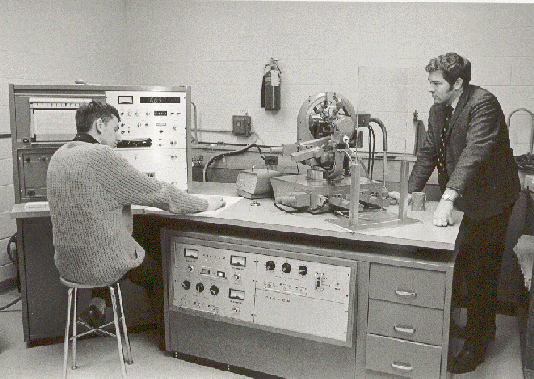
Fig. 6: 1975 photo of the X-ray diffractometer, with undergraduate assistant John Marley (left), and Dr. Bev Robertson (right).
Early versions of automated X-ray diffraction equipment were based on card-feed readers and printers and were, at best, problematic. The new Regina equipment was no exception. Dr. Robertson had been involved in fine tuning the design of the Picker diffractometer while at Cornell, and had just finished dismantling the same equipment and reassembling it elsewhere as part of a move by the Cornell group to new quarters. He was then in a good position to get the Regina equipment up and running, and this led to an initial phase of strong research productivity for the group, which in addition to Stanley and Robertson, included a postdoc and several graduate students. Dr. Stanley left the US-RC in 1972, but nevertheless, the group continued to grow. R.J. Barton joined the group in 1980, and L.M. Mihichuk (Chemistry) became closely associated with it. By the early 80's, it consisted of three faculty members, two post docs, a visiting faculty member, a technician and six students, for a total of 13 people.
The group conducted a series of studies in the 1970's of the p-molecular interactions of organic compounds, in collaboration with Drs. Norbert Karl and John Stezowski of the University of Stuttgart. The Regina group developed a strong interest in the causes of unusual molecular packing and carried out many studies during the 70's and 80's, attempting to explain pseudo-symmetry, super-lattice structures, inclusion compounds and polymorphism. Dr. Robertson also became involved in the development of crystallographic software, in particular the optimization of the numerical analysis procedures used in crystallography. Collaborations with chemists involved the study of fluxionality in seven-coordinate inorganic compounds, and conformations of icrylhydrazines and bridged diphenyl compounds.
An unusual study explained the difference between the powder patterns used to legally prove that a sample seized in a drug case was free base cocaine. The single crystal structure was determined and used to calculate the powder-pattern lines. The remaining lines showed the presence of different impurities in both of what had been assumed to be pure cocaine by the authorities.
As the field of crystallography matured, it began to be seen less as fundamental research, and more as a service to other fields of science. New research was initiated on determining the subtle differences in the distributions of the charge densities and electrostatic potentials of a series of similar nucleoside analogs that are substrates of macromolecules involved in the life cycle of the herpes viruses and the human immunodeficiency virus, and which were responsible for the differences in the biological activity of the substrates. This new area of crystallographic research required the collection of data capable of giving very high resolution to the crystal structure. Although the Regina diffractometer had been upgraded several times over the years, it was not well suited to this new task.
The group's activity led to the publishing of 77 refereed publications, one of which was used as a training manual for students of charge-density crystallography in other laboratories. Agencies in the U.S. and Canada began pulling back from the funding of charge-density crystallography in the mid 1990's, although the area was now gaining strength in Europe. With the retirement of Drs. Barton and Robertson, the group dissolved in 1997.
3 - RESEARCH IN NUCLEAR AND PARTICLE PHYSICS
A research program in nuclear spectroscopy was initiated at the new campus in 1966 by J.L. Wolfson, S.I.H. Naqvi, and S. Hontzeas (adjunct member from the Chemistry department). A large portion of this research was aimed at angular correlation studies between the parent and daughter nuclides, both beta-beta and beta-gamma, to determine the level decay schemes of each. By studying both, the conversion coefficient (for conversion electron emission) can be determined. For this purpose, Dr. Wolfson built an ''orange type'' magnetic spectrometer for the beta-beta studies, and Dr. Naqvi built a beta-gamma spectrometer utilizing a Ge(Li)-NaI coincidence system. The spectrometers were used initially at the US-RC, with radioisotopes ordered from Chalk River, and later at the University of Manitoba cyclotron, where the proton beam was used to produce short-lived parent isotopes for study. In addition, Dr. Hontzeas installed a neutron generator on campus to produce isotopes for gamma-ray spectroscopy. The gravity wave project eventually consumed all available local resources, and research in subatomic physics in the department took a back seat until the mid-1980's.
In 1983, the intermediate energy (experimental subatomic) physics group was established with the invitation by the department to Dr. Lolos, who had just been awarded a NSERC University Research Fellowship (URF), to start a new research program in this area. The first University of Regina students working on nuclear pion production and pion absorption experiments at TRIUMF also began at this time. As a result of this early and successful research initiative, further expansion became possible and after agreements between Physics, Chemistry, and the Faculty of Science, another faculty position for intermediate energy physics was created. This resulted in Dr. Mathie joining the department in 1984. Both Drs. Lolos and Mathie established research programs at TRIUMF on proton-nucleus and pion-nucleus interactions, and at the time, the Regina group was the only one in the country with independent research programs in each of TRIUMF's proton and meson beam halls. Dr. Mathie's program concentrated on pion-deuteron interactions while Dr. Lolos' pursued pion absorption and polarized proton induced pion production on light nuclei.
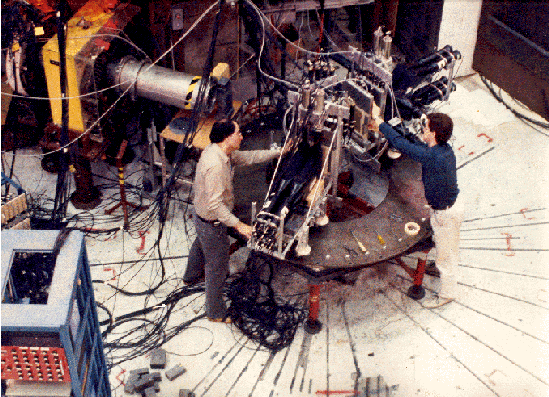
Fig. 7: Dr. Lolos (left) with graduate student (and eventual faculty member) Z. Papandreou (right) setting up the apparatus for a 1986 pion absorption experiment at the M11 pion channel at TRIUMF.
The growth of the experimental group, named REGIE (Regina Experimental Group in Intermediate Energy), and the increased number of graduate students in the department, created the need for a theoretical physics position in subatomic physics. With the generous assistance of TRIUMF under Dr. Vogt (director), a position in theoretical intermediate energy physics was created in anticipation of future departmental retirements, allowing Dr. Mobed to join the department. The same year witnessed the formal association of University of Regina and the CEBAF lab (Continuous Electron Beam Accelerator Facility) , in Newport News, Virginia, through a memorandum of understanding (MOU) for the development, design, and construction of major detector elements for the two HRS spectrometers in Hall A. The University of Regina was the first Canadian university to sign such an agreement with CEBAF (now known as Jefferson Laboratory, or JLab, for short), and the close association continues to this day.
In keeping with the intended development of the KAON project at TRIUMF, the university, TRIUMF, and the government of Saskatchewan reached an agreement formalizing the TRIUMF-University of Regina relationship to that of associate membership. A new research scientist position was created in the department, to be matched by a TRIUMF research scientist position attached to the University of Regina. Drs. Huber and Tacik joined the department in 1989-90 as University of Regina and TRIUMF research scientists, respectively, thus allowing both the TRIUMF and CEBAF branches of research within the department to continue and grow. Drs. Mathie and Tacik joined with a new collaborative effort at TRIUMF to build the Canadian High Acceptance Orbit Spectrometer (CHAOS) for pion physics. When the KAON funding effort ran into difficulty, Drs. Lolos and Huber increased their efforts at CEBAF, laying the foundation for further expansion into the field of physics using electromagnetic probes to study the properties of hadrons. Under the CEBAF MOU, Drs. Lolos and Huber brought large grants from CEBAF/DOE into Canada and initiated a successful technology transfer to industry with resultant commercial sales in Canada and abroad. These grants not only sustained research during a particularly difficult NSERC funding situation, but gained the department additional international exposure and reputation.
In 1994, a new faculty position was approved for an experimental physicist with emphasis on CEBAF-based research, and Dr. Huber joined the department in his new capacity as faculty. With the research development effort fulfulling the terms of the CEBAF MOU coming to a successful completion, and imminent arrival of the first CEBAF beam putting its initial scientific program within reach, new experimentalist faculty positions were approved. Dr. Papandreou joined the department in 1995, and was followed by Dr. Brash in 1996-7, via a joint effort between the University of Regina, JLab, and Rutgers University. By this time, the team of Drs. Brash, Huber, Lolos, and Papandreou adopted a new group name, SPARRO (Subatomic Physics at Regina with Research Offshore), thus officially creating two separate but mutually supporting experimental groups within the department. The REGIE group of Drs. Mathie and Tacik continued their research at TRIUMF, and SPARRO had JLab as the main base, but also had projects at INS-ES (University of Tokyo) and Brookhaven National Laboratory (BNL).
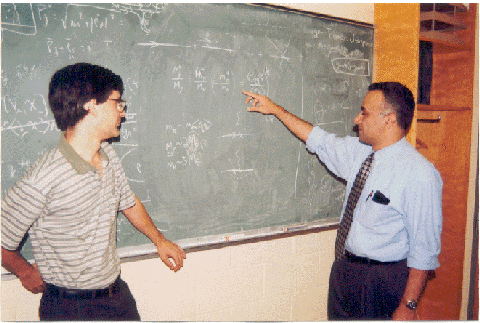
Fig. 8: Drs. Lewis and Mobed discussing a research question.
The interests of the SPARRO group center on vector meson mass modification in hadronic matter (Drs. Lolos, Huber, and Papandreou) at the INS-ES facility in Tokyo using the TAGX spectrometer, rare eta decay studies at BNL (Papandreou), pion form factor measurements (Dr. Huber) in Hall C at JLab and proton electric form factor measurements (Dr. Brash) in Hall A, also at JLab. The form factor program is ongoing at JLab and all four faculty members of SPARRO are now part of the HAll D collaboration, a new project to investigate the role of glue and the origin of confinement by the production of exotic hybrid mesons at JLab, with the 12 GeV energy upgrade of the latter.
The REGIE group now leads the CHAOS collaboration at TRIUMF, to pursue pion-nucleus interactions with precision and phase space coverage not available to the field before. Particular emphasis was put into testing QCD inspired theories at low energies and medium modifications in the two pion system in nuclei. The group has also contributed to a new precision measurement of the Michel parameters of muon decay.
The rapid expansion of the experimental subatomic physics group, and the trend to higher energies, as well as towards the QCD aspects of nuclear physics, created the need for an increased theoretical physics activity and presence within the department. In 1997-8, with the cooperation of Jefferson Lab, another position was established in the theory group, and Dr. Lewis joined the department at that time. The department now enjoys a solid place in QCD related research in the non-asymptotic freedom region, such as Chiral Perturbation Theory and Lattice Gauge Theory.
IV - TOWARDS THE FUTURE
The department has witnessed the trials and tribulations of a young university created in the 1960's, during the great university expansion across the nation. From a college tradition, the department was thrust explosively into the high profile research undertaking of building a state of the art gravitational wave detection laboratory. Even though ultimately the project was terminated before it was given a chance to attempt actual measurements, the large size of the project, the concept of critical mass in a research group, and the development of local expertise, all left a lasting legacy. The decline that followed reflected the university's own search for an identity as much as the department's own exhaustion after such a large investment in human and material resources.
The concept of a young and active group acting as a core of research activity, and as a springboard for a new generation of faculty members, was put into play in the mid-1980's, with the creation of REGIE. The national and international nature of subatomic physics research and the association, first with TRIUMF, and then also CEBAF, together with visionary leadership within the department and the faculty of science, built upon strength and resulted in an orderly and phased-in replacement of retirements, by pre-buying and timely replacements. Although the department is not up to the numbers of faculty it had in the early 1970's, its reputation, research grants, quality of graduate students, and international strength have never been higher. The future is always full of challenges and pleasant, as well as unpleasant, surprises, but the department is particularly well positioned to fulfill its research and educational mandate at the highest possible standards in the disciplines of subatomic physics, both experimental and theoretical.
